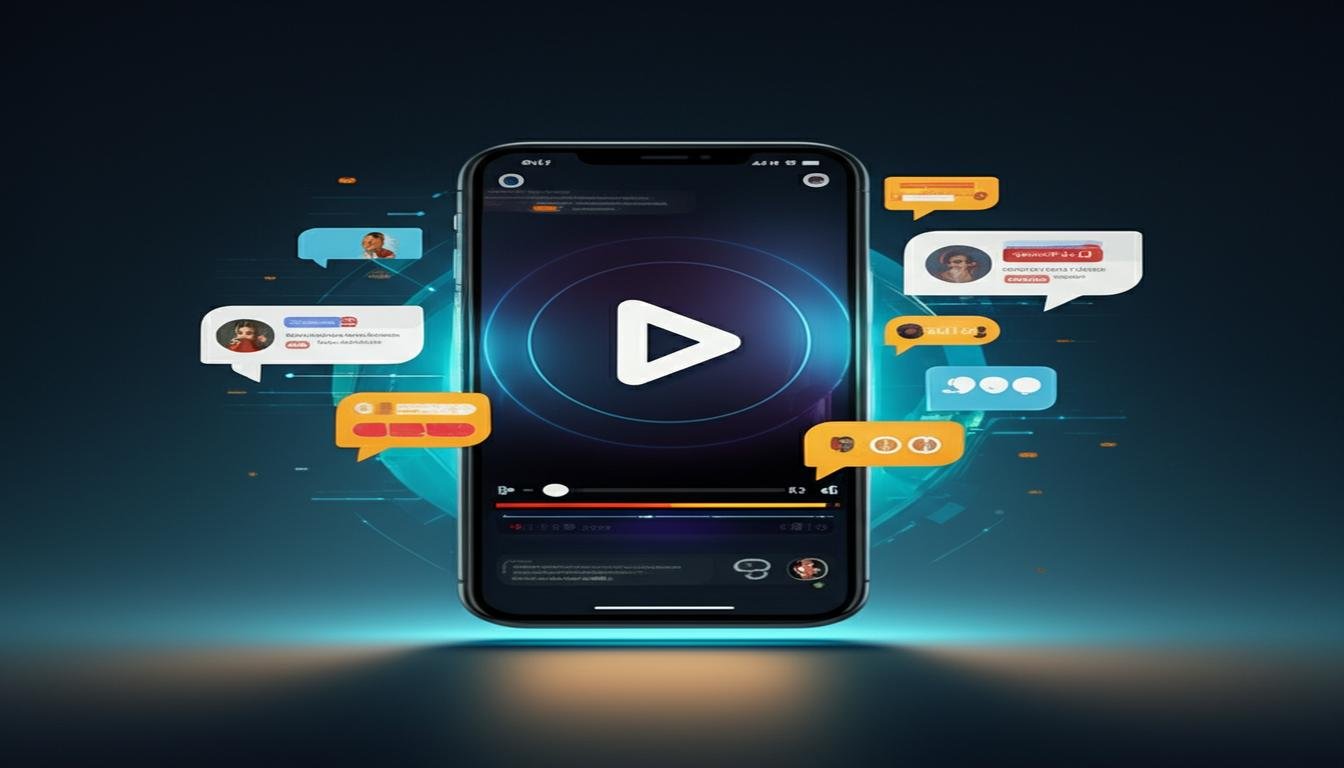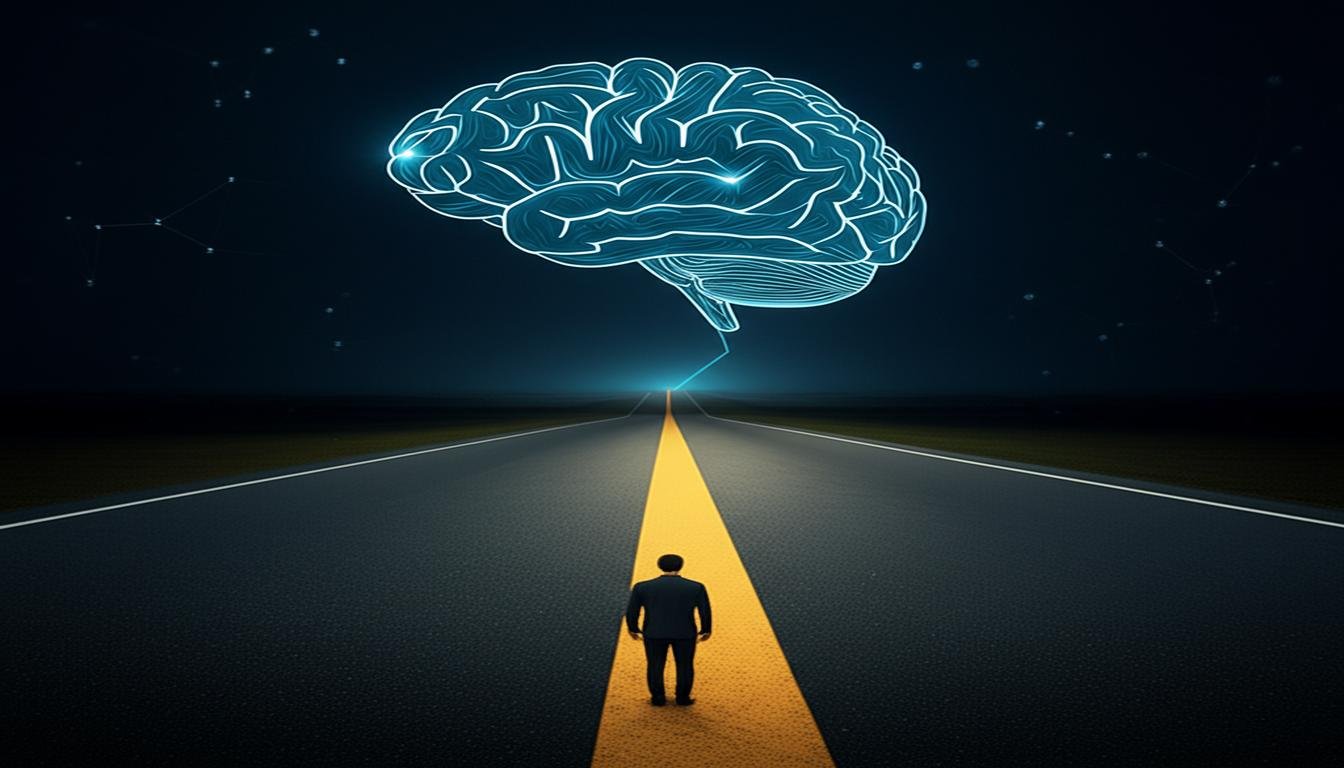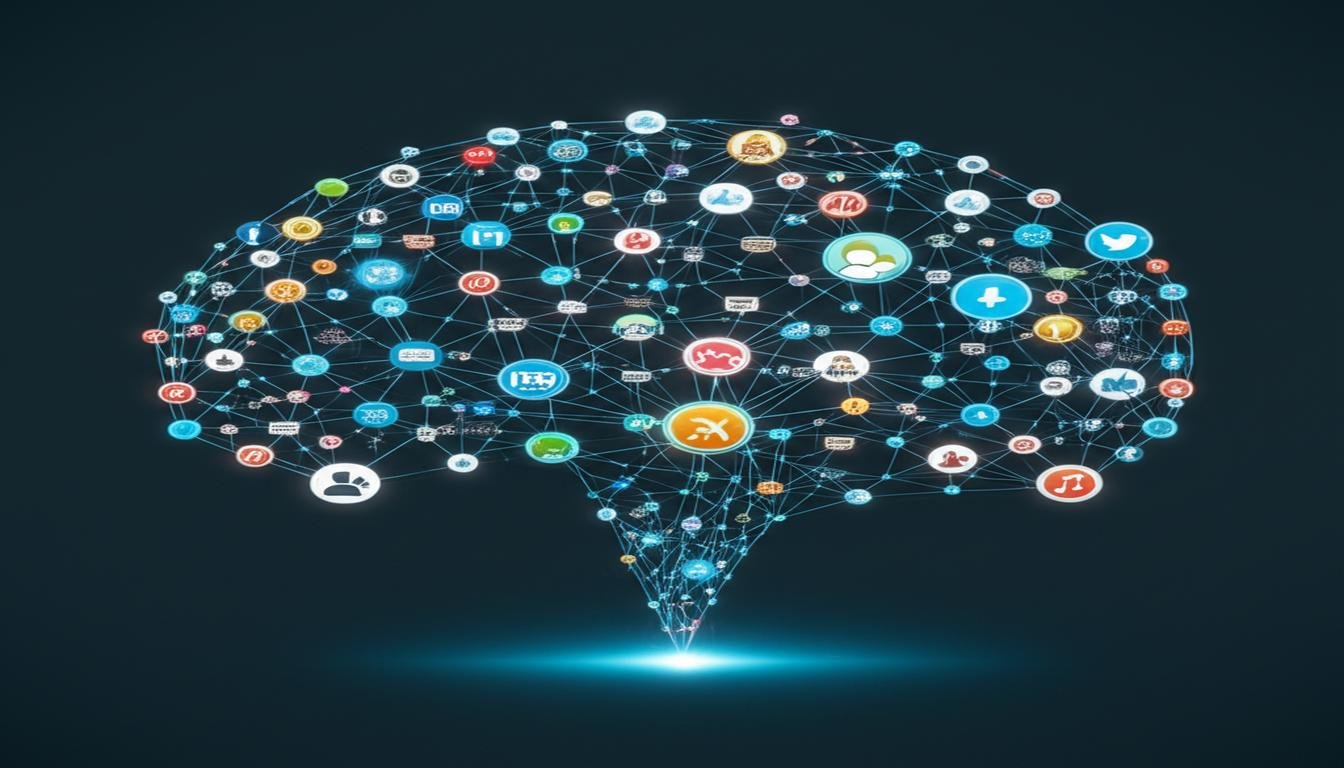Did you know McKinsey predicts AI could create 20–50 million new jobs globally by 2030? While many worry about AI replacing jobs, it’s actually changing careers in ways we’re just starting to see. AI is not just about robots taking over jobs. It’s about boosting human abilities and opening up new possibilities.
Take North Carolina State University’s AI Academy, for example. It teaches professionals how to work with AI. This shows a key point: to thrive in the future, we need to learn new skills, not fight against AI. In fields like healthcare and manufacturing, combining human and AI efforts leads to breakthroughs we couldn’t achieve alone.
This change also brings challenges. McKinsey says about 14% of workers might need to find new jobs by 2030. But there’s a bright side: jobs in data analysis, AI ethics, and tech support are on the rise. The key is to learn how to adapt, not fight, these changes.
Table of Contents
Key Takeaways
- AI could generate 20–50 million new jobs worldwide within this decade
- Human-AI collaboration drives innovation across industries
- Workers may need to transition careers, focusing on complementary skills
- Educational programs like NC State’s AI Academy lead workforce preparation
- Technical and ethical oversight roles show strong growth
The Evolution of Workforce Technologies
Imagine walking through a 19th-century textile mill where steam-powered looms rattled nonstop. Now picture Amazon’s warehouses today – silent except for the hum of robots. This shows how workforce technologies have changed from old machines to smart systems that learn.
From Mechanization to Cognitive Automation
The first industrial revolution replaced human muscles with machines. Steam engines and assembly lines took over factories. Workers became just parts of a big machine. Now, in the 21st century, AI workforce automation does tasks that need to recognize patterns and make decisions.
- Mechanical Mastery (1800s): Textile mills automated weaving, increasing output 50x
- Digital Disruption (1970s): Computers introduced precision but required manual programming
- Cognitive Leap (2010s): Machine learning algorithms adapt through experience
Amazon’s Kiva robots show this change. These orange machines move 70% of warehouse inventory using machine learning in the workplace. They don’t just move fast – they get better over time.
What makes cognitive automation special? Old technologies followed strict rules. Today’s AI handles unexpected situations. For example, quality control systems now find defects humans might miss by comparing products to millions of images.
This change doesn’t make humans obsolete. It changes our roles from doing repetitive tasks to overseeing and planning. You’re now training algorithms and understanding their results.
Also Read: What Stage of AI Are We In?
AI in the Workforce: Current Adoption Trends
Businesses around the world are quickly adopting AI tools. This creates a fast-changing scene where more jobs are being created than lost. A World Economic Forum report shows that 133 million new jobs have been made thanks to AI. At the same time, 75 million jobs have been lost.
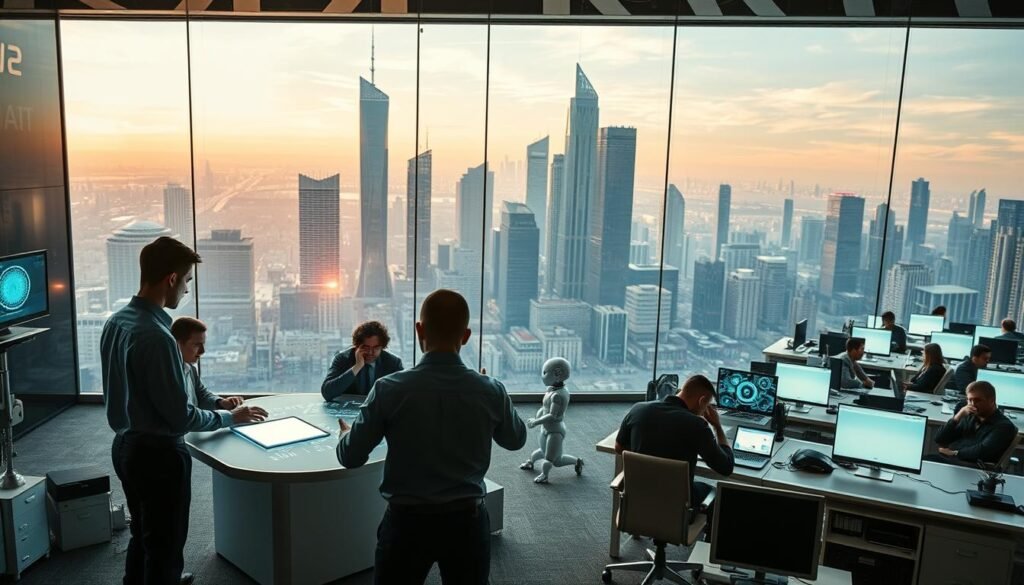
Industry Adoption Rates Across Sectors
AI use varies a lot between different fields. Manufacturing is at the top, with 62% using AI for tasks like quality checks and predicting when machines need maintenance. Healthcare is at the bottom, with 35% using AI mostly for helping with diagnoses.
Here are some key comparisons:
- Financial services: 58% use AI for fraud detection
- Retail: 47% deploy chatbots for customer service
- Transportation: 41% implement route optimization tools
A Salesforce survey found something interesting. 68% of workers are happier when they don’t have to do the same tasks over and over. This shows that AI tools often help people do their jobs better, not just replace them.
Geographic Distribution Patterns
Three areas are leading in AI use:
| Region | Key Strength | Major Players |
|---|---|---|
| Silicon Valley | Startup innovation | Google, OpenAI |
| Beijing | Government-backed R&D | Baidu, SenseTime |
| Singapore | Cross-industry integration | Grab, DBS Bank |
New places like Bangalore and São Paulo are also growing fast in AI. They are seeing a lot of new jobs in customer service automation. These areas have a lot of young tech talent who are quick to learn new AI tools.
Industry-Specific AI Implementations
Artificial intelligence is changing the game in many industries. It’s not just about making workplaces more efficient. It’s about solving unique problems and raising big questions about impact of AI on jobs. Let’s look at how two big sectors use AI in different ways.
Manufacturing’s Intelligent Revolution
John Deere’s smart tractors are a great example of AI in manufacturing. They use:
- Soil sensors to check moisture levels
- Weather prediction algorithms
- Maintenance alerts for parts
This setup cuts down on equipment downtime by 27% every year. FedEx also uses AI to speed up hiring. They can now find the right candidate in just 10 minutes, thanks to automated skills tests.
Healthcare’s Precision Partner
The da Vinci Surgical System shows AI’s power to save lives. At Mayo Clinic, AI models help with:
| Application | Accuracy Rate | Human Benchmark |
|---|---|---|
| Tumor Detection | 94.7% | 88.2% |
| Medication Error Prevention | 99.1% | 92.4% |
| Patient Risk Prediction | 89.3% | 76.8% |
These tools don’t replace doctors. They help doctors make more accurate diagnoses. Nurses using AI for triage see emergency response times drop by 35%.
As industries tailor AI solutions, the impact on jobs changes a lot. Next, we’ll see how these changes affect daily productivity in different sectors.
Workforce Productivity Enhancements
Artificial intelligence is changing how we measure and boost productivity. It automates tasks and offers advanced decision tools. This lets companies work more efficiently and focus on solving complex problems. Let’s look at two key areas where this change is happening.
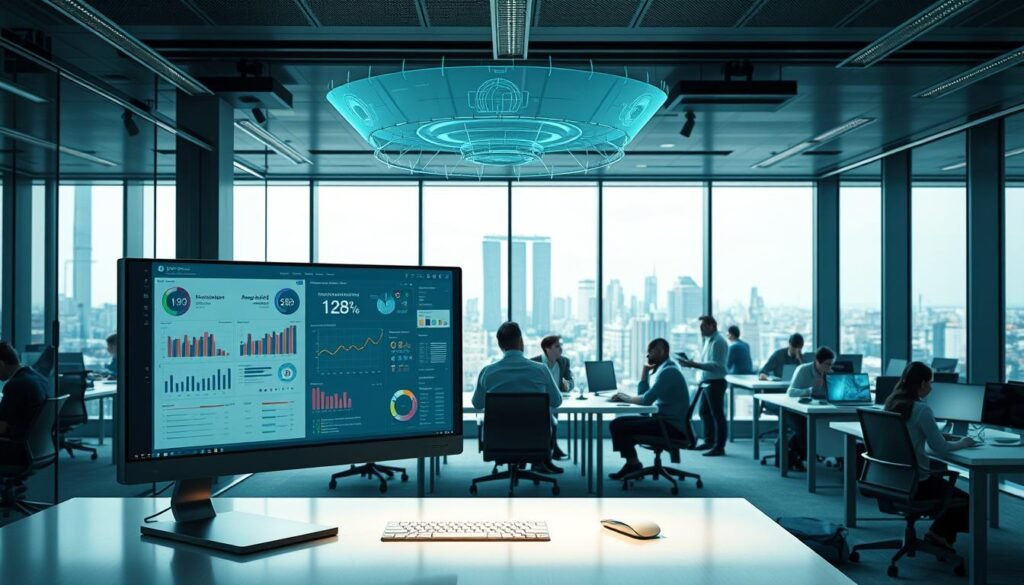
Streamlining Mundane Operations
AI is great at handling repetitive tasks that take up a lot of time. For example, Amazon’s robots help process orders 40% faster by handling inventory. This isn’t just for physical tasks:
- AI cuts down invoice processing time by 65% for accounts payable teams
- Chatbots handle 80% of routine customer service inquiries
- Computer vision makes quality checks 90% faster in manufacturing
| Department | Automated Task | Time Saved |
|---|---|---|
| Finance | Invoice processing | 12 hours/week |
| Retail | Inventory management | 30% fewer stockouts |
| Healthcare | Patient scheduling | 45% faster bookings |
Enhancing Strategic Decisions
AI does more than just automate tasks; it also improves human decision-making. Walmart uses AI to analyze 72 data points per product. This helps predict demand and cut overstock by $300 million a year. AI is now used for:
- Real-time credit risk assessments with 95% accuracy
- Forecasting supply chain disruptions 6 weeks ahead
- Personalized employee training suggestions
These systems don’t make decisions on their own. They give insights that help humans make better choices. A loan officer might look at AI’s risk scores but also consider special cases. This way, AI and human empathy work together.
Job Market Transformations
Artificial intelligence is changing jobs fast, opening new doors but closing others. This means we all need to think about learning new skills and planning our workforces. Let’s look at how AI is changing jobs in different fields.
Emerging AI-Related Professions
Now, companies want people who can mix tech skills with human needs. AI trainers – those who teach machines to understand data – are in high demand, up 340% from 2020. Ethics officers for AI are also growing fast, in places like Silicon Valley and Boston.
IBM shows this change clearly. They’ve grown their AI jobs from 20% in 2016 to 50% in 2024. They’re looking for people in roles like:
- Machine learning operations engineers
- AI-powered cybersecurity analysts
- Conversational interface designers
| Role | Projected Growth (2024-2030) | Median Salary |
|---|---|---|
| Robotics Engineer | 45% | $112,000 |
| AI Ethics Specialist | 62% | $98,500 |
| Automation Architect | 57% | $127,000 |
Displaced Occupations Analysis
AI is creating new jobs but also making some old ones obsolete. Jobs like data entry and basic accounting might drop by 18-23% by 2027. AI chatbots in retail banking have cut customer service jobs by 14%.
The change isn’t the same everywhere. Jobs on assembly lines in manufacturing might fall by 9% with robots. But, quality control jobs could rise by 12% with better monitoring.
| Declining Roles | Reduction Rate | Emerging Alternatives |
|---|---|---|
| Administrative Assistant | 21% | Workflow Automation Manager |
| Traditional Data Analyst | 17% | Predictive Modeling Specialist |
| Basic Customer Support | 29% | AI-Human Interaction Designer |
This change in jobs shows we need to learn new skills. People moving from old jobs to new ones often do well. It’s about seeing AI as a chance to grow, not just a threat.
Corporate AI Implementation Case Study
Looking at AI workforce automation in action, Amazon’s changes stand out. The company used robotics and training to improve its operations. This shows how to use new tech while growing your team.
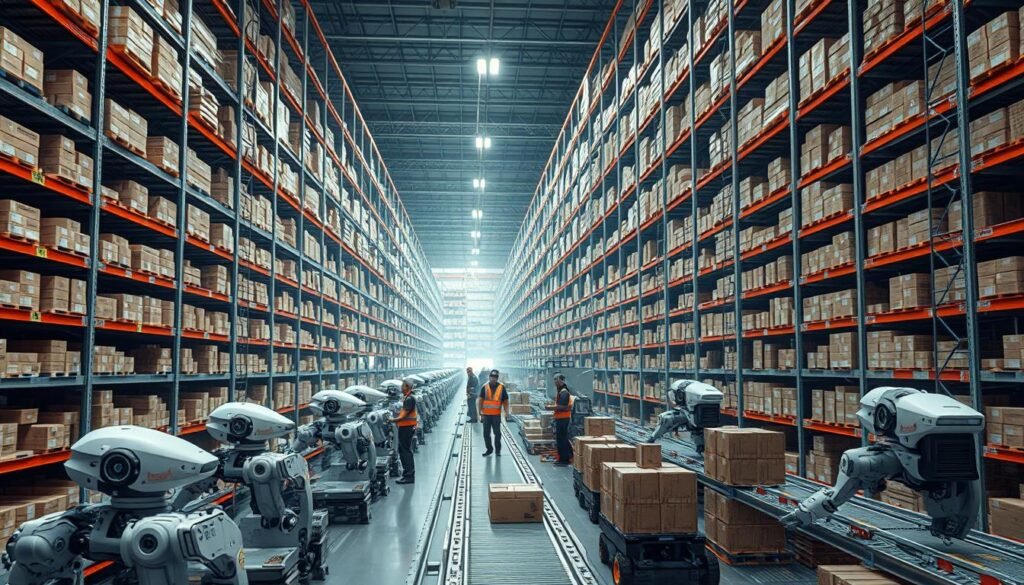
Amazon’s Warehouse Automation
Amazon spent $700 million on Kiva robotic systems. These robots changed how warehouses work, with over 50,000 machines in use. The orange robots:
- Now find items in 15 minutes, down from 90
- Increased storage by 50% with better layouts
- Helped process orders 2.5 times faster during busy times
Our robotics integration isn’t about replacing people – it’s about reimagining how humans and machines can collaborate safely and productively.
Workforce Adaptation Strategies
Amazon faced worries about the future of work with AI. So, it started Career Choice to make warehouse workers tech experts. The program includes:
- Prepaid tuition for fields like data analysis
- Training labs with AR tools
- Partnerships with 140+ community colleges
Over 50,000 workers got new tech roles thanks to this. Maria Gonzalez, a former picker, says: “Learning automation monitoring skills tripled my salary while keeping me essential to operations.”
Amazon’s story shows that AI workforce automation needs tech and people investments. Seeing employees as upgradeable assets, not just costs, helps companies stay ahead. This way, they keep their teams strong and operations running smoothly.
Ethical Considerations in AI Deployment
As companies use more AI, they face big ethical questions. Two main issues are algorithmic bias in hiring tools and expanding workplace surveillance capabilities. These problems make us question how to keep up with innovation while protecting human rights.
Algorithmic Bias Challenges
AI systems can pick up on human biases if their training data is flawed. Amazon’s failed recruiting tool is a clear example. It learned to lower scores for resumes with words like “women’s” or mentions of women’s colleges.
This shows three main problems:
- Training data that reflects old biases in hiring
- Lack of diversity in the teams that develop AI
- Not testing AI for bias well enough
The EEOC is now making companies check their hiring AI for bias. Microsoft stopped selling facial recognition to police, showing they’re starting to understand the risks.
Worker Surveillance Concerns
AI systems now watch everything, from how fast you type to when you take breaks. The EU wants to ban AI that can read emotions in the workplace because it’s a privacy issue. The main worries are:
- Always watching you at work, making it stressful
- Collecting biometric data without asking
- Getting in trouble for not being productive enough
Big tech companies are under a lot of pressure to control themselves. Microsoft has limited how much it watches in the workplace. Unions want to know more about what’s being monitored.
We need to work together to solve these problems. We should check AI often, make sure it’s developed with input from workers, and have clear rules. As AI changes work, we must always remember to protect human dignity.
Workforce Reskilling Initiatives
To bridge the AI skills gap, companies and governments must innovate in training. Automation is speeding up, and 60% of workers will need new skills by 2027, says the World Economic Forum. This has led to partnerships between businesses and public bodies to secure jobs for the future.
Corporate Training Programs Leading the Charge
Companies are now investing in upskilling. IBM’s “New Collar” program mixes classroom learning with real-world AI projects. This approach skips the need for traditional degrees. A company executive explains:
We’re creating pathways where skills trump credentials – it’s about what you can do, not just what you studied.
3M’s digital literacy program shows its success:
- 40% faster onboarding for legacy manufacturing systems
- 60% reduction in retraining time through VR simulations
- 85% employee retention rate among program graduates
Government-Sponsored Education Scaling Solutions
Public efforts are also helping. Singapore’s SkillsFuture program gives citizens $500 annual credits for AI courses. Germany has subsidized VR training for 280,000 auto workers.
In the U.S., NC State’s AI Academy works with local employers through:
- Industry-specific microcredentials
- Evening/weekend hybrid classes
- Project-based learning with regional manufacturers
| Initiative Type | Key Advantage | Participation Rate |
|---|---|---|
| Corporate Programs | Job-specific skills | 72% internal hires |
| Government Programs | Broad accessibility | 1.2M learners nationwide |
These efforts show that tackling how AI will impact the future of work needs both corporate and public action. As jobs change, learning new skills will be essential in the AI age.
Human-AI Collaboration Models
Companies are finding that mixing human skills with AI leads to unmatched operational synergy. Instead of replacing people, these systems boost human abilities and automate routine tasks. Let’s look at two new ways teams are working together.
Hybrid Workforce Structures
Salesforce’s Einstein AI shows how machine learning in the workplace can unlock human talent. It analyzes customer data, giving sales teams insights that cut analysis time by 35% and boost deal success.
Lockheed Martin goes further with their “human-machine teams” in aerospace. Engineers work with AI design helpers that:
- Simulate 10,000+ wing configurations overnight
- Spot structural issues in real-time
- Make compliance reports automatically
Cognitive Augmentation Systems
Stryker’s surgical AI highlights AI’s role in improving accuracy. Their system cuts procedure variability by 42% by:
- Creating 3D models before surgery
- Tracking instruments during surgery
- Reviewing performance after surgery
| Workflow Aspect | Traditional Approach | AI-Enhanced Approach |
|---|---|---|
| Task Allocation | Manual scheduling | AI-driven resource matching |
| Error Detection | Human review cycles | Predictive anomaly alerts |
| Decision Making | Experience-based choices | Data-backed recommendations |
These examples show that successful AI integration is about teamwork, not competition. As AI gets smarter, it becomes a key partner, not just a tool.
Economic Impacts of Workforce AI
Businesses using artificial intelligence see big changes in the economy. We’ll look at how AI boosts productivity and changes how wages are spread out. This shows both good and bad sides of AI in the workplace.

Productivity Growth Metrics
Studies by the OECD show companies with AI tools are 40% more productive than those without. This improvement comes from three main areas:
- Faster data processing for better decisions
- Less downtime thanks to predictive maintenance
- Smart use of resources with machine learning
A study by MIT found big differences in productivity gains. Tech hubs like Silicon Valley see twice the gains as rural areas. This shows that where you are and the resources you have matter a lot for AI’s economic benefits.
Wage Polarization Trends
Even with high productivity, how wages are paid is complex. The Brookings Institute found a 30% wage premium for those skilled in AI. But this leads to two main trends:
The AI skills premium isn’t just about coding – it’s about understanding how to work alongside intelligent systems effectively.
- AI jobs with high demand see 12-15% salary growth each year
- Jobs without AI skills see little to no wage increase, even with more work done
This wage gap is a big challenge for economic leaders. MIT found that cities with strong AI programs cut wage gaps by 18%. This is done by training workers, a strategy more companies are using to keep their teams balanced.
Regulatory Landscape Analysis
Artificial intelligence is changing how we work, and governments are working to keep up. In the U.S., there’s a mix of federal rules and state experiments. This creates a complex but changing environment for AI in the workplace.
Federal Foundations for AI Governance
The White House introduced the AI Bill of Rights in 2022. It sets out key rules for AI in the workplace. These include:
- Transparency in how algorithms make decisions
- Preventing AI from being biased
- Offering human options when AI takes over
This is different from the EU’s AI Liability Directive. The EU makes companies pay for AI-related problems. Now, the EEOC requires employers to check their hiring AI for bias.
State Laboratories of AI Regulation
States are trying out different ways to handle AI and work:
| State | Law | Key Requirement | Effective |
|---|---|---|---|
| Colorado | Algorithmic Bias Audit Act | Annual audits for hiring AI | 2024 |
| California | Workplace Monitoring Act | Disclose AI surveillance tools | 2023 |
| Texas | AI Innovation Sandbox | Exempts startups from some rules | 2025 |
In California, employers must tell workers about AI tools that watch their work. Texas has special areas for AI testing without fear of legal trouble.
This mix of rules is a challenge for big companies. But it also encourages new ideas. As one lawyer says:
We’re seeing states compete to either attract AI developers or protect workers – sometimes both at once.
Experts suggest companies:
- Check all AI tools against state laws
- Test AI for bias
- Update employee guides with AI info
With 27 states looking at new AI laws in 2024, the rules will keep changing. Keeping up helps businesses use AI wisely and stay legal.
Future Workforce Projections
By 2030, artificial intelligence will change workplaces a lot. About 45% of today’s jobs might not exist anymore. This change isn’t about replacing people, but about how we work with smart systems.
Research firms have different views on this change. They see both chances and challenges for workers in the future of AI.
2030 Employment Forecasts
Gartner says 80% of simple tasks will be automated in six years. But, some jobs will grow too. Oxford warns 20% of jobs might vanish, while McKinsey sees 12 million new AI jobs.
This shows a key point: career success will depend on adaptability.
| Research Firm | Job Creation Estimate | Displacement Estimate | Key Focus Area |
|---|---|---|---|
| McKinsey Global Institute | +12M jobs | -7M jobs | Human-AI collaboration |
| Oxford University | +5M jobs | -20M jobs | Technical reskilling |
| World Economic Forum | +9.8M jobs | -8.5M jobs | Ethical AI development |
Skill Demand Evolution
The question “what can artificial intelligence do today” shapes tomorrow’s skills. Three skills will be key for hiring:
- Prompt engineering for advanced AI systems like GPT-5
- Bias detection in machine learning outputs
- Cross-functional AI implementation strategies
Technical roles need a deep understanding of natural language processing. Leaders must know AI for making smart decisions. The U.S. Bureau of Labor Statistics says AI specialist jobs will grow 32% by 2030.
The workforce of 2030 won’t compete against AI – they’ll compete through AI mastery.
This change opens new doors for workers who keep learning. Those who know both their field and AI will lead in many areas. They show that human creativity is essential in the future of AI.
Corporate Leadership Strategies
AI is changing how we work, and leaders must find a balance. They need to adopt new tech while keeping human values at the heart. It’s not just about knowing the tech—it’s about leading with empathy and understanding.
Let’s look at ways to guide teams through AI changes. We’ll see how to keep everyone productive and happy.
Structured Change Management Frameworks
Top companies use clear plans to ease the transition to AI. Accenture’s 3-phase integration framework has helped over 120 businesses:
- Discovery Phase: Teams work together to find AI opportunities
- Pilot Phase: Small tests with feedback from various teams
- Scale Phase: Rollout to everyone with ongoing learning
Microsoft cut down on time to start using AI by 40% in factories. Cisco trained 1,200 people to help others use new tools. This led to 75% faster adoption.
Sustaining Engagement Through Transition
Getting employees on board is key to AI success. Unilever focuses on three main areas:
- Keeping everyone informed about when changes will happen
- Training for skills needed with AI
- Prizes for those who try new things first
Teams that got regular updates on AI progress adopted tools 74% faster than others.
Smart companies mix these methods with listening to their teams. They use surveys and AI feedback portals. This way, leaders can fix issues before they get big, fostering a team that works together.
Conclusion
The use of ai in the workforce is changing how businesses work and how people use technology. Companies like IBM show the importance of always learning. They refresh their skills every 45 days to keep up with AI and the future of work.
This method helps with both technical skills and the ethics of using AI. It’s key for businesses to succeed in a world with more technology.
Amazon’s work in warehouses and healthcare shows AI can help people, not just replace them. It’s about finding the right balance between technology and human creativity. This balance is what makes a hybrid work environment work.
Rules on AI are changing to deal with its effects on jobs and money. Programs like NC State University’s AI certification help workers keep up. These efforts aim to meet the skill needs of the next decade.
Leaders need to create a place where humans and AI work together well. They should support training and certifications to keep teams ready for change. The future of work with AI depends on using technology wisely and empowering people.
FAQ
How does AI workforce automation compare to past industrial revolutions?
AI is different from past revolutions. It uses sensors and machine learning to automate tasks. This leads to big productivity gains but also changes the workforce.
Which industries are adopting AI workforce solutions fastest?
Manufacturing is leading with 62% adoption. This includes John Deere’s AI for maintenance. Healthcare is catching up, with 35% adoption for things like Mayo Clinic’s AI diagnostics.
Can AI actually create more jobs than it displaces?
Yes, AI can create more jobs than it takes away. For example, robotics engineering is growing 45%. IBM has also increased AI jobs from 20% to 50% by reskilling employees.
What are proven strategies for implementing workplace AI without employee backlash?
Amazon and Cisco have shown how to do this. Amazon trained 300,000 workers in data analysis. Cisco involved employees in AI design, reducing resistance by 75%.
How can companies prevent algorithmic bias in AI hiring systems?
Companies can use audits and human checks to avoid bias. The EU and California have laws to ensure fairness in AI hiring.
What government initiatives support AI workforce transitions?
Germany and Texas offer training and innovation support. IBM and 3M also provide apprenticeships and digital literacy programs to help workers adapt.
How does human-AI collaboration boost productivity in practice?
Collaboration between humans and AI can greatly improve productivity. For example, Lockheed Martin and Stryker have seen big reductions in development time and variability.
What regulatory differences exist in global AI workforce governance?
The EU has strict AI rules, while Texas is more open. California requires disclosure of monitoring algorithms. China focuses on productivity over privacy.
Which skills will be most valuable in the AI-driven 2030 workforce?
Skills like prompt engineering and data literacy will be key. McKinsey says 75% of jobs will need basic analytics. Oxford warns that 14% of jobs may disappear.
How are leading companies measuring AI’s workforce ROI?
Companies like Walmart and Accenture track AI’s impact. Walmart has seen a 30% drop in stockouts. Accenture uses a metric called the automation quotient. OECD data shows AI can increase productivity by 40%.










